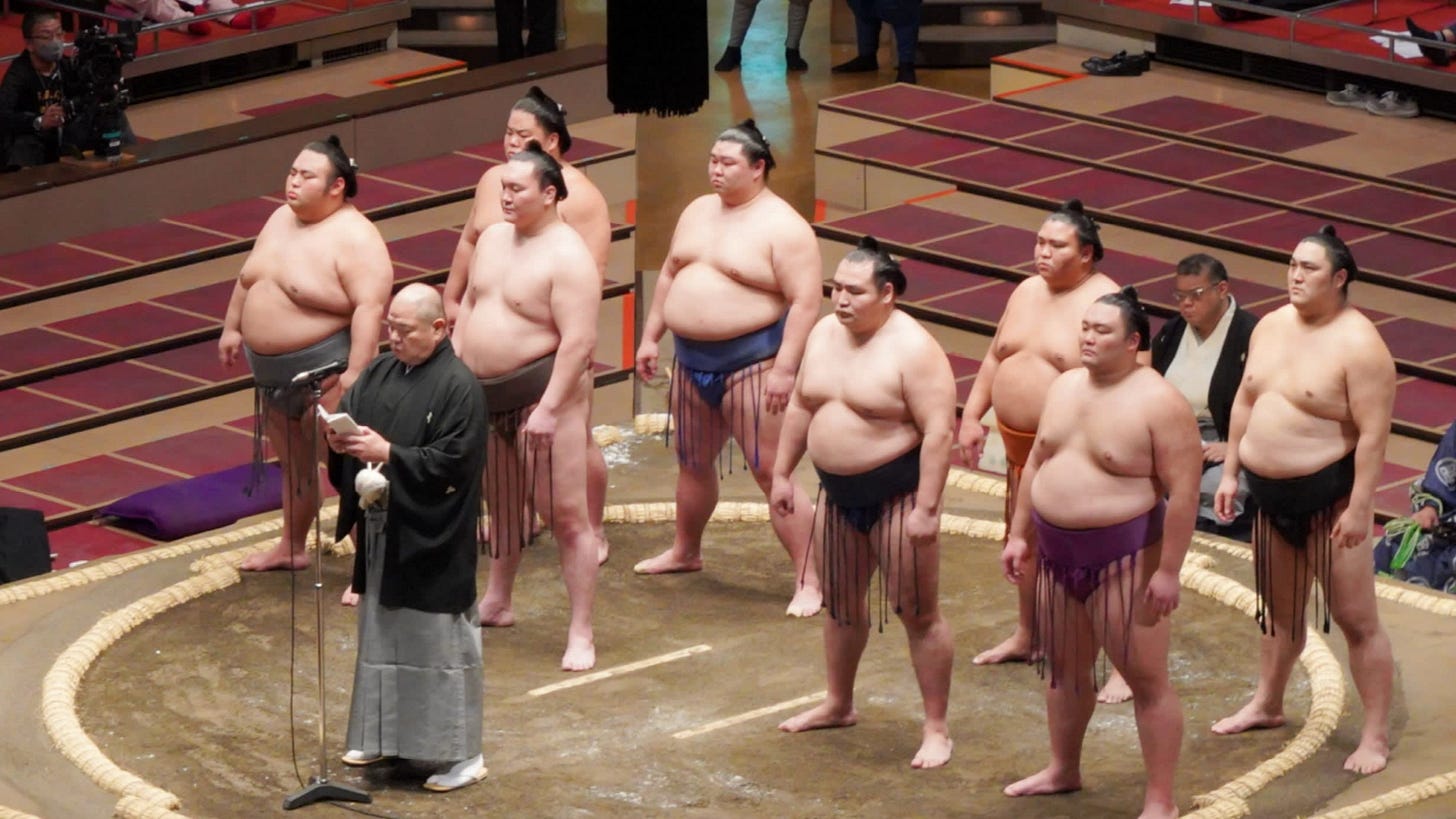I drafted this last Sunday while sitting on my couch watching the first day of the delayed July sumo tournament. I wasn’t quite sure what to do with it, but we’ve hit the midway point of the basho and I still can’t decide so I might as well post it here. It’s a little different than a normal Fight Prose entry, but there you go. Worry not, we’ll finish the Hector Echevarria movie marathon on Wednesday. (Glossary follows for the sumo-challenged.)
This past Sunday afternoon was the first day of a new basho, always a momentous occasion like a brand-new Christmas morning, but instead of unwrapping holiday sweaters and fruit cake, it’s the gift of cherubic rikishi thwacking into each other, fighting for position, one loses, one wins. Long minutes pass between bouts, salt is thrown, the dohyo is watered and swept.

And there are fans in attendance! Sumo is better with fans, the pageantry and ceremony feel incomplete in empty halls. The last basho was cancelled, the one before done without spectators. We’re here because - well you know why we’re here - but more specifically to sumo in May a lower-ranked rikishi named Shobushi Kanji succumbed to coronavirus. Despite being sick for days, he was initially unable to be hospitalized due to overcrowding and bureaucracy. He was 28.
As a result of pandemic precautions, the Ryogoku Kokugikan is at 25 percent capacity, around 2500 fans – football and baseball stadia in Japan have been limited to 5000 spectators. The numbers of infected in Tokyo have soared in recent weeks. Along with opening up sporting venues, the government has set out a plan to encourage domestic tourism with large discounts on travel and accommodation. Like capillaries, the tracks of the shinkansen are set to take the disease to the far reaches of the country.

The yobidashi sings the names of the next two competitors and they enter the ring. They bow and slap and shift and shuffle. Every night I hear the sounds of sirens screaming by outside; on the news it feels like the world has gone back to April and first wave of fear and uncertainty with the ever-increasing lines on the bar graph. The juryo boys begin; the makuuchi enter; the world moves briskly along. Strong oshi-zumo sends a rikishi sprawling off the dohyo and barreling into a shimpan. Life comes at you fast. Even with a 14-day incubation period.

By most measures, it seems Japan has weathered the global pandemic quite well. Somehow though it seems success has come despite most official measures: the unaccountable Diamond Princess, infighting and indecision wasting weeks of initial planning, months long delays in providing aid, the farce of Abenomasks, and now the mystifying Go-To Campaign. On the English-language NHK Sumo preview show for the July basho, the commentators didn’t mention Shobushi’s name, much less that a rikishi had succumbed to the disease, or even that one had ever been infected. Despite the eerie reflection of springtime in today’s news reports, the topic has shifted. At 25 percent capacity, a new tournament begins. At what cost, and at what discount, remains to be seen.
Glossary - *from wikipedia
basho (場所) - Venue. Any sumo tournament.
dohyō (土俵) - The ring in which the sumo wrestlers hold their matches, made of a specific clay and spread with sand. A new dohyō is built prior to each tournament.
jūryō (十両) - Ten ryō, for the original salary of a professional sumo wrestler. The second-highest division of sumo wrestlers, below makuuchi and above makushita, and the lowest division where the wrestlers receive a salary and full privileges.
makuuchi (幕内) or maku-no-uchi (幕の内) - Inside the curtain. The top division in sumo. It is named for the curtained-off waiting area once reserved for professional wrestlers during basho, and comprises 42 wrestlers.
mawashi (廻し) - The thick-waisted loincloth worn for sumo training and competition. Those of sekitori wrestlers are white cotton for training and colored silk for competition; lower ranks wear dark cotton for both training and competition.
oshi-zumō (押し相撲) - There are two main types of wrestling in sumo: oshi-zumō and yotsu-zumō. Oshi-zumō literally translates as pushing sumo, and is more commonly referred to in English as a Pusher (oshi)-Thruster(tsuki)… Oshi-zumō fighters are generally thought of as simplistic, while yotsu-zumō fighters are seen more as technicians.
rikishi (力士) - Literally, Powerful man. The most common term for a professional sumo wrestler, although sumōtori is sometimes used instead.
Ryogoku Kokugikan - home of sumo in Tokyo
shimpan (審判) - Ringside judges or umpires who may issue final rulings on any disputed decision. There are five shimpan for each bout, drawn from senior members of the Nihon Sumō Kyōkai, and wearing traditional formal kimono.
shinkansen - bullet train
yobidashi (呼出 or 呼び出し) - Usher or announcer. General assistants at tournaments. They call the wrestlers to the dohyō before their bouts, build the dohyō prior to a tournament and maintain it between bouts, display the advertising banners before sponsored bouts, maintain the supply of ceremonial salt and chikara-mizu, and any other needed odd jobs.



